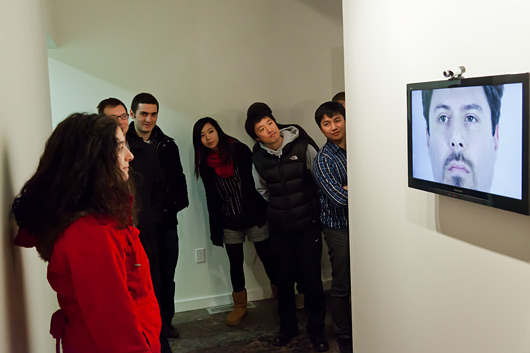Protocols of Looking
Protocols of Looking
interactive display, video monitor, cameras, computer, custom software
2011
Our conventions of behavior in social situations have been honed over thousands of years of human interaction. Respect personal space. Speak in a moderate volume. Don’t stare. These protocols serve many functions in civilized society, whether it’s to avoid confrontation, to facilitate communication, or to maintain power relationships. Following centuries of slow adaptation in response to cultural shifts, they are now running up against rapidly changing technological systems—systems that manage how and when we communicate and who we call our ‘friend.’
I’m interested in how these social protocols of old are being changed by digital systems. Alexander Galloway has explored how network protocols serve as a method of control rather than liberation, as a method of limitation rather than expansion. When considering our collective shift into technological social networks such as Facebook, how are our personal interactions being affected by those systems?
To explore this question I created the interactive installation Protocols of Looking. Here I provide two simulated situations: a face-to-face interaction where who looks when is very much in the fore, and a more covert setup where the subject can’t see themselves as object. In the former, the viewer literally can’t look the electronic face in the eye, as that face constantly tries to avoid direct confrontation. In the latter, those who engage the electronic face, intentionally or not, set themselves up to be watched by others.
This installation allows me to examine one particular aspect of social protocol and how it’s being changed by technological networks: looking at others. In physical social spaces, whether it’s a coffee shop or a street corner, we constantly engage in a covert voyeurism, watching others until we’re in danger of being caught. Once that danger presents itself, whether we’re caught looking or not, a flick of the eyes in another direction is the developed protocological response that maintains social order. I’m interested in how this protocol is being changed by online social networks. What happens when we can look all we want without that danger? What does it mean when we can be watched indefinitely by anyone anywhere without our ever knowing it? And what kind of informatic advantage does this shift provide to the technological systems that both enable and require it?
